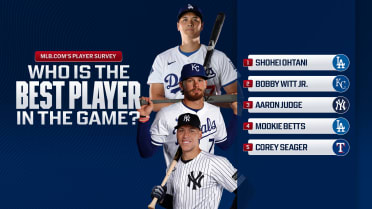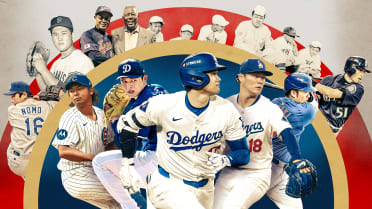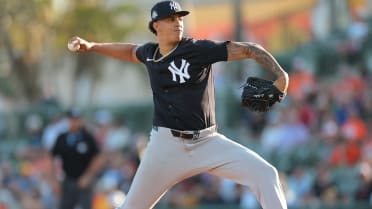How Paxton's Seattle reunion came together
SEATTLE -- For James Paxton and the Mariners, their one-year reunion is rooted in comfort. Big Maple wanted a chance to show the American League that he has recovered from his injury-plagued 2020 and can re-emerge as one of its elite left-handed starters, while Seattle sought a cost-effective bridge to its younger stable of arms.
Their $8.5 million agreement -- which can reach $10 million through very achievable performance bonuses and was finalized Thursday -- was a manifestation of more than three months of correspondence dating back to the onset of free agency in November. After the big lefty regained confidence in his mechanics following a strained left flexor tendon he sustained in August, Paxton held an open bullpen session days before Christmas at the Athletic Training Institute in Bellevue, Wash., a stone’s throw from T-Mobile Park.
In attendance, Mariners general manager Jerry Dipoto, assistant GM Justin Hollander and manager Scott Servais observed intently, watching Paxton fire his entire arsenal with no limitations across 45 pitches. Given that the 20 other teams in attendance also witnessed Paxton’s potential, Seattle's brain trust departed thinking there wasn’t a strong chance to bring him back. So, the Mariners diverted their attention to their roster needs for a left-handed bat that could play second base and left field, though those efforts wound up fruitless.
“I think after the first 10 or 12 [pitches], I said, 'This guy is ready to roll,'” Servais said. “I have to say, when I walked out of that bullpen session with Jerry and Justin, I didn't know what kind of chance we'd have to sign [Paxton]. But it worked out for us. And once in a while, you got to get a little lucky, and I’m very thankful that he's coming back.”
Ownership continued to check with Dipoto in January, seeking developments in Paxton’s market. Paxton, who grew up 130 miles from T-Mobile Park in Ladner, British Columbia, was a fan favorite during his six seasons with Seattle, posting a 41-26 record and a 3.42 ERA across 102 starts. As the Mariners march through their rebuild with a payroll that Cots Baseball Contracts projects will approach $72 million after this agreement, Paxton represents a big-ticket item.
“We didn't really think that it was a high likelihood that we were going to be able to score a top-impact-type starting pitcher,” Dipoto said. “One of the big benefits is how much James wanted to play in Seattle. I don't think there's any question that ... we were the benefactors of some form of hometown discount on this.”
Paxton, 32, drew significant interest from the Mets and Blue Jays but ultimately settled for familiarity in his first go-round of free agency. If he maxes out the performance incentives -- Paxton can earn an additional $750,000 after finishing his 10th and 20th games, according to MLB Network insider Jon Heyman -- he still falls shy of the $12.5 million pre-prorated rate in his final year of arbitration that he was slated to earn in 2020’s shortened season.
It was a year Paxton is eager to put behind him, beyond the social and personal challenges of the pandemic. Paxton finally decided to have back surgery in February 2020 after months of pain that dated back to his final three starts of 2019. Paxton wouldn’t have been ready until late May, so when he returned to the Yankees in Summer Camp in July, he was fueled by adrenaline to compete for a spot on a postseason-bound club, and his eagerness maybe got the best of him.
“I thought that I was OK,” Paxton said. “But looking back at it now and looking at my mechanics, my back leg just wasn't getting off the rubber very well. And it was making my arm drag behind me, and everything was just moving slow because of that. And it actually put my arm in a dangerous position.”
What followed were five forgettable starts, a career-high 6.64 ERA, velocity charts way down from his typical 95 mph average and a season-ending strained left flexor tendon. But thankfully, no Tommy John surgery.
“That’s what I think caused the injury to my flexor, just my mechanics being off and not having my strength back to 100 percent,” Paxton said. “So, I really focused this offseason on getting my strength back and my core and my back and did a lot of work on my mechanics. And I'm back to feeling really good right now.”
That’s positive news for the Mariners, who know better than anyone how dominant Paxton can be at his peak -- and also how susceptible he has been to the injured list during his eight-year career. Since he debuted in 2013, the club’s fourth-round Draft pick in '10 has also been on the IL for elbow, pectoral, latissimus, finger and knee ailments that have prevented him from reaching the 30-start plateau for a single season or pitching beyond 160 1/3 innings.
Paxton is determined to exceed that threshold this year, and the Mariners’ plans for a six-man rotation will build in extra rest and recovery. Paxton should slot in as the No. 2 starter behind Marco Gonzales, one of just three remaining teammates (with Mitch Haniger and Kyle Seager) from Paxton's last go-round with Seattle.
“I would still personally like to get to at least 170 innings,” Paxton said. “So, I want to stay healthy and try and get to get to that mark. But I think that'll be possible in a six-man rotation. But the goal is to stay healthy for the entire season.”
Paxton’s next bullpen session will be his eighth since the injury. His velocity is around 92 mph, typical for this time of year, and he returns to a Mariners club that looks much different than the one he left. He says he’s ready to take on an Elder Statesman-type role -- even if he’s had a two-year hiatus.
“Coming back to Seattle was the best long-term decision for me,” Paxton said. “Looking forward in my career and what I want to do, I want to get back to being myself this year. I really struggled last year, coming back from the back surgery. I'm comfortable here in Seattle. I love the group here. And I'm excited to be part of it.”
Daniel Kramer covers the Mariners for MLB.com.




